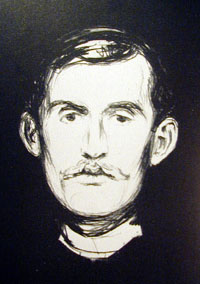GermanExpressionism.com >> Artist Index >> Edvard Munch Biography
1863-1944

View a selection of Edvard Munch Prints
Edvard Munch was born in Noway to a distinguished family. Munch's early childhood was marred by the deaths of his mother when he was four and his older sister when he was fourteen. He originally studied to become an engineer but abondoned this idea in 1880 to become an artist.
Initially he was influenced by the naturalist painter, Christian Krohg, whose studio was nearby. He was also influenced intellectually by the Bohemian circle in Oslo (formerly Christiana) especially by the free-thinking ideas espoused by Hans Jaeger. In 1886, he made an artistic breakthrough towards his distinctive style and subject matter with first versions of Sick Child, The Day After and Puberty. Between 1889-1892, he traveled to France where he became acquainted with Post-Impressionism and Symbolism.
In 1892, he was invited to exhibit his most recent works at the Verein Berliner Künstler in Berlin. This show upset members of the Verein and the press so much that after only eight days they voted to close the exhibition. Of course, this scandal made Munch an overnight celebrity among the avant-garde so he decided to move to Berlin where he spent most of the next sixteen years. Munch himself summed it up perfectly when he said, "All in all, I think I will make out well here in Germany."
In 1895, he completed a series of fifteen paintings entitled "Liebe" (Love) which includes some of his best known images. Many of these compositions he translated into etchings and lithographs. In 1896-97, he spent a year in Paris to take advantage of printing facilities there. It was during this trip that he first explored the woodcut medium. Most of his early woodcuts employ color. It was only in 1898-99 that Munch began to work in black and white. He deliberately emphasized the grain of the wood as a determining element of design, a technique that deeply influenced German artists.
In 1902, Munch exhibited an expanded version of his 1895 series which were titled "The Frieze of Life". Soon thereafter, however, his health deteriorated and he began to suffer from paranoia and uncontrolled drinking. This came to a climax in 1908 when he admitted himself to a clinic for nervous disorders in Copenhagen. When he was discharged, he returned to Norway where he would spend the rest of his life although he still maintained many connection to the German art world.
There is no record as to why Munch explored printmaking nor who taught him the techniques. Nonetheless, he produced 378 lithographs, 188 etchings and 148 woodcuts. Nearly all of Munch's portrait etchings and lithographs have no corresponding painted image. Few of the prints made after his collapse in 1908 are of much significance. (Paraphrased from The Print in Germany: 1880-1933 by Frances Carey and Antony Griffiths)